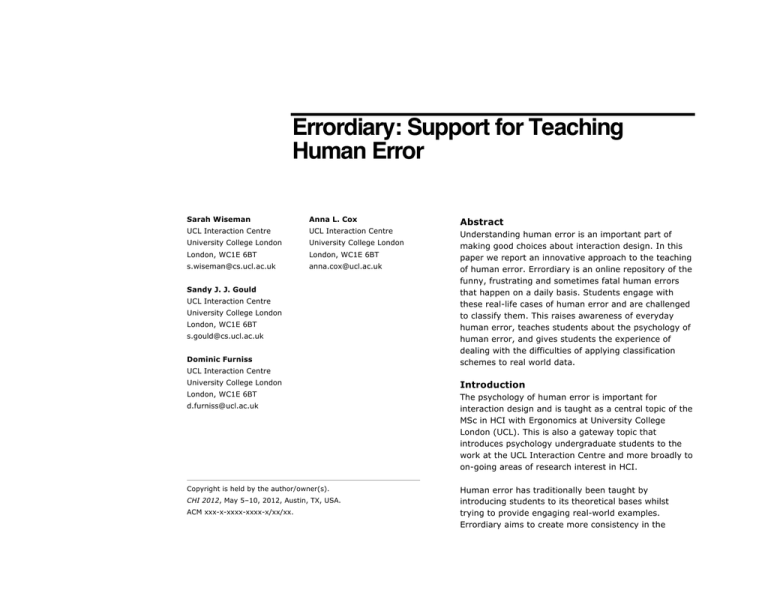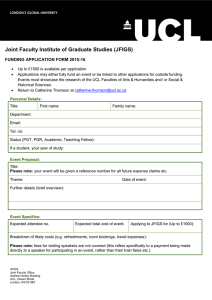Errordiary: Support for Teaching Human Error Abstract
advertisement

Errordiary: Support for Teaching Human Error Sarah Wiseman Anna L. Cox UCL Interaction Centre UCL Interaction Centre University College London University College London London, WC1E 6BT London, WC1E 6BT s.wiseman@cs.ucl.ac.uk anna.cox@ucl.ac.uk Sandy J. J. Gould UCL Interaction Centre University College London London, WC1E 6BT s.gould@cs.ucl.ac.uk Dominic Furniss UCL Interaction Centre University College London London, WC1E 6BT d.furniss@ucl.ac.uk Copyright is held by the author/owner(s). CHI 2012, May 5–10, 2012, Austin, TX, USA. ACM xxx-x-xxxx-xxxx-x/xx/xx. Abstract Understanding human error is an important part of making good choices about interaction design. In this paper we report an innovative approach to the teaching of human error. Errordiary is an online repository of the funny, frustrating and sometimes fatal human errors that happen on a daily basis. Students engage with these real-life cases of human error and are challenged to classify them. This raises awareness of everyday human error, teaches students about the psychology of human error, and gives students the experience of dealing with the difficulties of applying classification schemes to real world data. Introduction The psychology of human error is important for interaction design and is taught as a central topic of the MSc in HCI with Ergonomics at University College London (UCL). This is also a gateway topic that introduces psychology undergraduate students to the work at the UCL Interaction Centre and more broadly to on-going areas of research interest in HCI. Human error has traditionally been taught by introducing students to its theoretical bases whilst trying to provide engaging real-world examples. Errordiary aims to create more consistency in the 2 examples used in teaching by providing a real-life data set for students to engage with. Errordiary is an online public repository of human error. People contribute to it by using the #errordiary hashtag through Twitter. However, even without a Twitter account Errordiary entries can be viewed, favourited and commented on at www.errordiary.org (see figure 1). This initiative was initially borne out of the need to raise awareness of human error research through public engagement. Realising its potential for teaching we have since incorporated it into human error teaching. Figure 1 Screen shot of the errordiary.org website Lecture Content The exercise was introduced in the middle of a 2-hour lecture. This lecture gave students an overview of the human error literature; beginning with Reason’s work on slips and mistakes [2], moving on to taxonomies of error [3]. The idea of using Norman’s action cycle to classify error types was then introduced to the students. Each error type was explained and an example provided. These examples were drawn from Norman’s original paper [1] and personal experience. The lecture slides had been used to teach classes before, without the Errordiary exercise. Errordiary Classification - The Exercise The exercise was initially developed for a psychology undergraduate class on Human Error. The lesson was run as part of a Human Computer Interaction module, it was delivered to 20 students and ran at the end of the 8-week module. This same exercise is now being delivered to students taking the Applied Cognitive Science module on the MSc Human-Computer Interaction with Ergonomics. Teaching Objectives The objectives of this exercise covered both curriculum and transferable skills building. The exercise was intended to support teaching of Norman’s Error Classification [1] and improve understanding of human error. The task itself helped to develop learning communities within the class by encouraging discussion between students. It was also intended that the exercise give students a chance to practice their research skills by applying learned techniques to realworld messy data. In terms of materials the whole lecture comprised of: • Lecture slides • Access to www.errordiary.org • An error classification worksheet Classifying Errordiary (The Exercise) The students were asked to pair up and look at the Errordiary website whilst the concept of the site was explained. After this brief introduction students were given a worksheet with all error types listed and asked to populate the error type table with examples from Errordiary, making sure to note down the unique reference number for each error so they could share it with their peers later. For example, error number 816 from errordiary.org, "On my way to work realized I was supposed to be working in a different office today. #facepalm #errordiary" could be classified according to Norman’s categorization of action slips as a capture error. 3 The students were advised that not every error would be easy to classify and indeed, not every error would be classifiable using Norman’s Error Classification scheme. The students were encouraged to discuss and defend their classification choices between themselves. If students had personal examples of any of the error types they were encouraged to record those too. A total of 20 minutes were set aside for this task. After this time, the students were asked to read aloud the errors they had classified and the class collectively discussed whether they agreed or disagreed with this classification. This discussion lasted 10 minutes, after which the lecture continued. Student Experience The students were highly engaged with the task. After an initial period of familiarisation the students were enthusiastic about attempting the exercise. The students not only discussed the task amongst themselves but also engaged in discussion of the material with the lecturers. Overall the students found the task engaging and challenging, which is to be expected as even experienced researchers find human error classification difficult. The intention of this task was to allow the students to explore the concepts introduced in the lecture, it was not a test of their knowledge. The exercise was also designed to introduce the students to the difficulties of applying theory and classroom-learnt techniques to real world messy data. The students appeared to enjoy the task, and some were able to suggest their own personal Errordiary experiences for the class to classify together. Conclusion Errordiary has been used to develop an innovative and engaging exercise that teaches students about human error. Critically, it provides the opportunity for students to apply theory to real world data in a very practical way. Human error classification is not without its challenges and consequently it provides lessons for their research practice and limitations in applying theory. These issues are engaged with through practice and class discussion. We highlight those Errordiary entries where similar psychological theory underlies both trivial and fatal human error stories to emphasise its importance. Future plans for Errordiary include making it more interactive so learning is shared between classes that are disparate in time and place; and making its use as a teaching resource attractive to people in industry. Acknowledgements We would like to thank Dr Maartje Ament for her work developing the Errordiary website. The development of this task was facilitated by discussions with Dr Gaelle Villejoubert, University of Kingston. This work is supported by the CHI+MED project, EPSRC grant EP/G059063/1 References 1. Norman, D. Categorization of Action Slips. 1981. 2. Reason, J. Human Error. Cambridge University Press, 1990. 3. Wiseman, S., Cairns, P., and Cox, A. A taxonomy of number entry error. BCS Conference on HCI, (2011).

